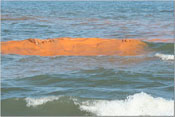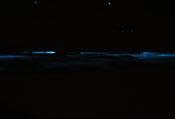Other Harmful Algae
Microscopic algae are an important part of the Gulf of Mexico's natural makeup as they serve as food for fish and other organisms. Algae do not have to be toxic to be considered harmful. Nontoxic algae can reproduce, or bloom, at such a high rate that they rob the water of available oxygen, which can result in fish kills. Likewise, some algae have spines or other protrusions that may cause fish kills simply by getting caught in or otherwise irritating fishes' gills. Following are some examples of both toxic and nontoxic HABs that have been found in Texas waters.
Akashiwo sanguinea
Akashiwo sanguinea is a dinoflagellate that caused a large fish kill along Bolivar Peninsula in September 2007. Whether or not this species is toxic has yet to be determined, but it is thought that fish kills most likely occur because of large-scale blooms that result in low oxygen levels in the water.
Alexandrium monilatum
Alexandrium monilatum is a dinoflagellate that forms chains of cells attached to each other. A. monilatum has caused red tides and fish kills along the Texas coast but there have not been any incidents attributed to it in recent years.
Blue-green algae
Blue-green algae are also called cyanobacteria because they are biologically similar to bacteria in many ways. As single cells, large colonies and filaments, blue-green algae grow in a wide variety of conditions and can become dominant in nutrient-rich water bodies. One characteristic of these cyanobacteria is their ability to form blooms so thick it appears that blue-green paint covers the surface of the water.
Two forms found in Texas are known to produce substances which cause taste and odor problems in water supplies. In some cases, blue-green algae, particularly Anabaena and Microcystis (both found in Texas), can produce toxins that are poisonous to fish and wildlife that drink water contaminated with the toxins. Fish kills have occurred in private stock ponds as a result of blue-green algal blooms and there have been a few reports of livestock dying from drinking water contaminated with blue-green toxins. In addition to toxicity to fish and wildlife, there are documented cases of blue-green algal toxins harming humans in other parts of the world through the consumption of poorly treated waters. Awareness is growing of the need to ensure blue-green algal toxins do not pass through water treatment plants without being adequately removed.
Is blue-green algae affecting a water body near you? To find out, contact the controlling authority of that water body. To find the controlling authority for lakes in Texas visit the Lake Finder page. The Texas Parks and Wildlife Department responds to harmful algal blooms when there have been impacts to fish or wildlife but does not conduct regular water quality testing or monitoring of water bodies in lieu of any reported fish and wildlife kills. Any ongoing water quality testing or monitoring would be conducted by the governing water controlling authority that manages a particular area.
The World Health Organization recommends the following for all freshwater-based recreation:
- Avoid areas with visible cyanobacterial or algal concentrations and/or scums in the water as well as on the shore. Direct contact and swallowing appreciable amounts are associated with the greatest health risk.
- Where no scums are visible, but the water shows strong greenish discoloration and turbidity, test if you can still see your feet when standing knee-deep in the water (after wading in without stirring up sediment). If not, avoid bathing— or at least avoid ingestion of water, i.e., submersion of your head. In such situations, avoid waterskiing because of potentially substantial exposure to aerosol toxins.
- If sailing, sailboarding or undertaking any other activity likely to involve accidental water immersion in the presence of cyanobacterial or algal blooms, wear clothing that is close fitting in the openings. The use of wet suits for water sports may result in a greater risk of rashes, because cyanobacterial or algal material in the water trapped inside the wet suit will be in contact with the skin for long periods of time.
- After coming ashore, shower or wash yourself to remove cyanobacterial or algal material.
- Wash and dry all clothing and equipment after contact with cyanobacterial or algal blooms and scum.
Ciguatera
Ciguatera is a form of poisoning that occurs after eating fish contaminated with ciguatoxin. Ciguatoxin is produced by a genus of harmful algae that live on the bottom or attached to structures, especially reefs. These harmful algae tend to occur in tropical or subtropical waters. The harmful algae are consumed by small fish which are then eaten by predator fish. Humans who consume the predator fish may become poisoned. Symptoms of poisoning can be varied and involve the gastrointestinal and the nervous systems. One typical symptom is temperature reversal, when objects that are cold, feel hot, and objects that are hot, feel cold. Ciguatoxin has been found in some barracuda caught in the Gulf of Mexico off the Texas coast. There is no red tide or other sort of discoloration of the water or bloom associated with the algae producing ciguatoxin. The dominant species that produces the toxin is type of unicellular plant named Gambierdiscus toxicus. It is distributed throughout the tropics in all all oceans.
Based on a U.S. Food and Drug Administration advisory, the Texas Department of State Health Services is advising recreational fishermen to avoid consumption of the following fish species captured within 10 miles of the Flower Garden Banks National Marine Sanctuary: marbled grouper (Dermatolepis (Epinephelus) inermis), hogfish (Lachnolaimus maximus), blackfin snapper (Lutjanus buccanella), dog snapper (Lutjanus jocu), gag grouper (Mycteroperca microlepis), scamp grouper (Mycteroperca phenax), and yellowfin grouper (Mycteroperca venenosa). Also included in the advisory are the following species captured within 50 miles of the sanctuary: yellow jack (Carangoides (Caranx) bartholomaei), horse-eye jack (Caranx latus), black jack (Caranx lugubris), king mackerel (Scomberomorus cavalla), amberjack (Seriola dumerili), and barracuda (Sphyraena barracuda).
There have been increasing reports of ciguatera occurring from fish caught off the Texas coast. In one instance three people were sickened by a barracuda caught approximately 30 miles off of Matagorda Bay near an oil platform. Subsequent reports have involved fish caught near the Flower Garden Banks National Marine Sanctuary. This species is commonly reported as a toxic species from the Caribbean as well.
TPWD wishes to thank Dr. Tracy Villareal of the UT Marine Science Institute for contributing the ciguatera text on this page.
Euglena
Euglena are single-celled animals with a single flagella. They can be common in very nutrient-rich waters like stock ponds and sewage lagoons. Water with Euglena blooms may appear bright pea green in color. Scientists recently confirmed a case where a particular species of Euglena caused a fish kill in a North Carolina fish farm. The species of Euglena that caused the fish kill can turn red during daylight hours, thereby causing a sort of freshwater "red tide."
Noctiluca scintillans
Noctiluca scintillans
scintillans is a dinoflagellate that sometimes blooms along the Texas coast, turning the
water a red-orange color. The species itself is nontoxic but can result in
localized fish kills by accumulating and emitting toxic levels of ammonia.
N. scintillans is a particularly interesting organism in that is
bioluminescent and can cause the water to glow beautifully at night.
is a dinoflagellate that sometimes blooms along the Texas coast, turning the
water a red-orange color. The species itself is nontoxic but can result in
localized fish kills by accumulating and emitting toxic levels of ammonia.
N. scintillans is a particularly interesting organism in that is
bioluminescent and can cause the water to glow beautifully at night.
Pfiesteria
Pfiesteria is a type of dinoflagellate that is known to produce toxins that can kill fish. It is a single-celled dinoflagellate with two flagella but it is not an alga (it does not have chlorophyll nor does it rely on sunlight to produce its own food). Pfiesteria and Pfiesteria-like organisms are relatively new to science and much is still being learned about them. They have caused fish kills in nutrient-rich waters in some of the estuaries along the Atlantic coast of the United States. There is some evidence they may cause illness in humans with extensive contact with waters containing Pfiesteria.
Prorocentrum minimum
Dark water was noticed in Rockport Harbor by a TPWD game warden in 2010. Samples were collected and the cause of the mahogany-colored water was determined to be the dinoflagellate Prorocentrum minimum. The bloom has also been seen in Fulton Harbor. P. minimum can produce the toxin okadaic acid, though it has not been known to be a toxic species in Texas.